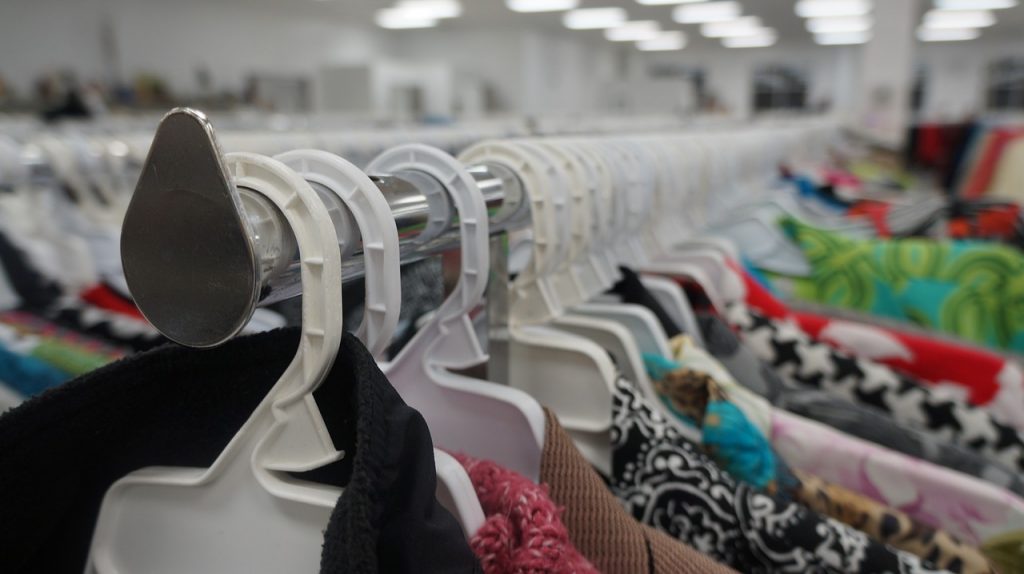Water – Use It Wisely is proud to feature guest bloggers who write about topics related to water and water conservation. This article was originally posted on WaterCalculator.org. It has been modified and reposted with permission. The original article can be found here.
Thrift Store Shopping Has become a Way of Life for Many People
The average American throws away 70 pounds of clothing every year. Many consider “shop ‘til you drop” a philosophy of life but that lifestyle comes at a high cost.
By the end of the 1990s – the golden years of shopping – shoppers were scooping up about 65 garments per person annually. Who doesn’t love a good sale?
Changing trends, new manufacturing technologies, and low prices prompted many Americans to indulge in “fast fashion” and over-consume clothing, but then the tide turned. Two recessions led many people to rethink their need for a closet full of new clothes. For some, conscious consumerism had supplanted the philosophy of overconsumption and many people started shopping less. Not everyone curbed their over consumptive fashionable ways, though. Eighteen years later and on average, consumers purchase 60 percent more items of clothing than they did in 2000, however, each garment is kept half as long.
Many used garments end up in landfills – the average American throws away about 70 pounds of clothing each year – this is roughly the equivalent of 191 t-shirts per person – and they recycle or donate only about 15 percent of their used clothing. That’s too bad because thrifting – buying clothes at a thrift store – is definitely having a moment that doesn’t show signs of ending soon.
Thrift store shopping has many benefits for people and the planet – here are five reasons why you should consider thrifting for both recycling and buying your clothes.
Thrifting Reduces Water Footprints and Uses Fewer Chemicals
Water is involved in almost every stage of clothing production. It takes water to grow cotton: it takes up to 2,700 liters (713 gallons) of water to grow the cotton needed to make one t-shirt; a pair of jeans takes over 8,000 liters of water.
Decreasing demand for new cotton decreases the need for the pesticides required to grow it.
Thrifting Uses Less Energy
It takes energy to transport cotton from farms to textile manufacturing facilities, to retailers and ultimately to consumers. Within the manufacturing process, a lot of energy consumption occurs during washing, de-sizing, bleaching, rinsing, dyeing, printing, and finishing processes. It also takes water to produce the electricity used to power all these processes.

Throwing clothes in a landfill also requires energy. Buying secondhand keeps clothes out of landfills which saves energy because more wear is gotten from that piece of clothing. In fact, a 2007 study found that recycling or reusing cotton clothing uses just 2.6 percent of the energy required to manufacture a garment from virgin materials.
Finally, as the use of cotton in garments has slowed, the use of polyester has jumped. Polyester has its origins in both natural and synthetic (think ‘oil and gas’) sources. Experts estimate that 98 percent of future fabrics will be synthetic and 95 percent of those synthetics will be polyester. As demand for clothing increases, demand for synthetic polyester fabric will increase and that brings with it all the environmental issues associated with oil and gas.
Thrifting Creates More Thoughtful Consumption
According to the EPA Office of Solid Waste, Americans threw away about 65 pounds of clothing per person in 2015. That adds up to about 16 million tons of clothing and textiles every year.
Shopping at thrift shops can help consumers make more thoughtful purchases. They can ask themselves, “Will I actually wear this? Will it go out of style? Do I truly need it?”
Thrifting is Cheaper
The average American consumer spends $1,000 to $2,000 each year on clothing, but wears only about twenty percent of what’s in their closet. While thrifting generally takes more time and consideration, it saves money, as long as people don’t “bargain overload” and don’t buy unnecessary pieces.
Thrifting Gives Back to the Community
National thrift stores like Goodwill provide career support for the disabled. Here is a national directory of charity-driven thrift stores, and a list of thrift shops around the United States to check out. Consignment stores, flea markets, and vintage shops also sell recycled clothing.


